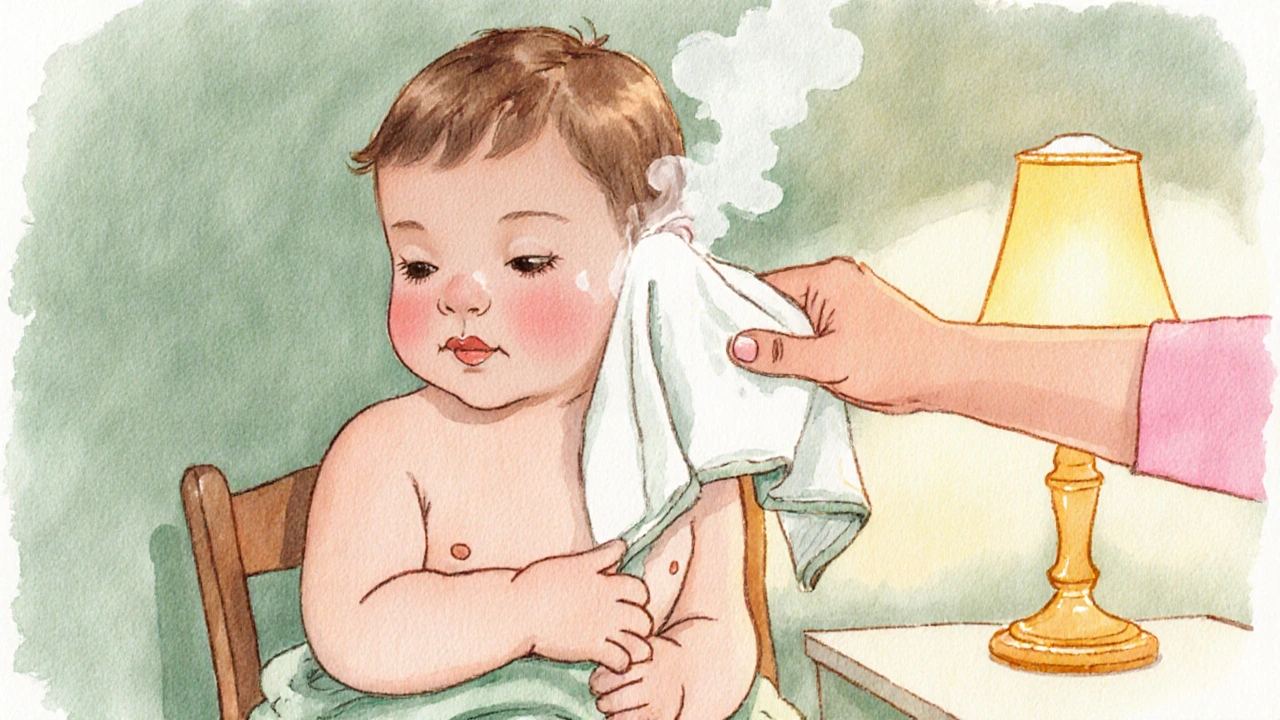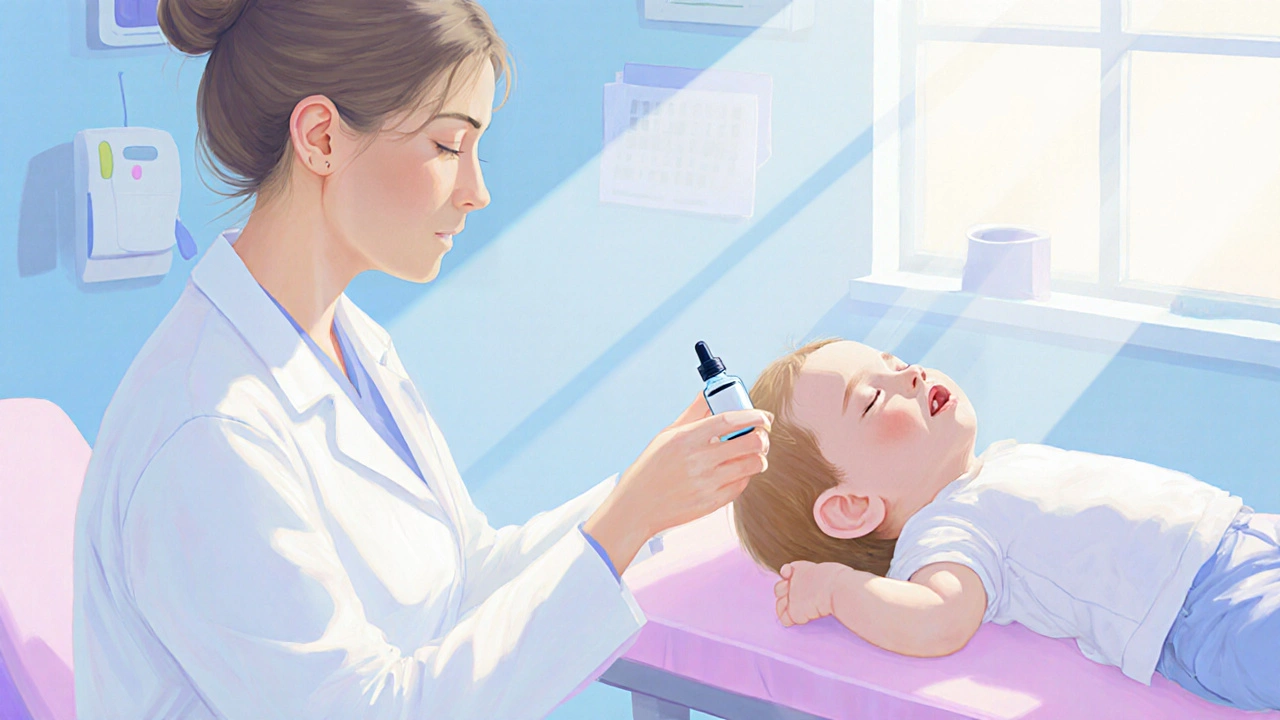Treating Ear Canal Infections in Babies & Toddlers: Safe Steps for Parents
 Oct, 13 2025
Oct, 13 2025
Ear Infection Symptom Checker for Babies
Assess Your Baby's Symptoms
Check all symptoms your baby is experiencing to determine urgency of medical care.
Additional Risk Factors
Check any factors that might be contributing to the infection.
Severity Assessment
Next Steps
When a newborn or a little one starts tugging at their ear, cranking up the volume on the whining, or refuses to eat, many parents immediately wonder: is it just a little ear wax or something more serious? ear canal infection babies is the phrase you’ll see on pediatric websites, and it’s not something to ignore. An ear canal infection, medically known as otitis externa, can turn a happy toddler into a miserable one in hours. The good news? With the right knowledge, you can spot the signs early, comfort your child at home, and know exactly when a doctor’s visit is non‑negotiable.
What Is an Ear Canal Infection?
Ear canal infection is a inflammation and bacterial or fungal invasion of the external auditory canal, the tube that leads from the outer ear to the eardrum. It’s often called “swimmer’s ear” in adults, but kids get it too-especially when water gets trapped, or a foreign object (like a cotton‑bud) irritates the skin.
While otitis media (middle‑ear infection) is more common in infants, otitis externa can sneak up during summer trips, after a bath, or even from excessive ear cleaning. In babies, the ear canal is shorter and more horizontal, which means moisture stays longer, making infection easier.
Spotting the Symptoms Early
Symptoms include:
- Redness or swelling in the ear canal (you might see a tiny pink line if you gently pull the ear back).
- Discomfort when the ear is touched or when your child moves their head.
- Fussiness, especially during diaper changes or bedtime, because lying down can increase pressure.
- Fever above 100.4°F (38°C) in younger infants.
- Drainage - a clear, yellow, or brown fluid oozing from the ear.
Because babies can’t tell you what hurts, watch for signs like refusal to feed, crying more than usual, or pulling at the affected ear. If you notice any of these, start the care plan right away.
Common Triggers and Risk Factors
Understanding why the infection happens helps you prevent it. The biggest culprits are:
- Excess moisture: Baths, swimming, or even heavy perspiration can fill the canal.
- Ear cleaning: Using cotton swabs or small objects disrupts the natural protective wax.
- Skin conditions: Eczema or dermatitis around the ear makes the skin more vulnerable.
- Upper‑respiratory infections: Congestion can spread bacteria to the ear canal.
Babies with a family history of ear problems or those who wear hearing aids are also at higher risk.

Safe Home‑Care Steps
Before you rush to the pharmacy, here’s a step‑by‑step routine you can try at home, provided the symptoms are mild and there’s no high fever.
- Keep the ear dry: After a bath, gently pat the outer ear with a soft towel. Avoid inserting anything into the canal.
- Warm compress: Soak a clean washcloth in warm (not hot) water, wring out excess, and hold it gently against the affected ear for 5‑10 minutes. Warmth can ease pain and improve blood flow.
- Pain relief: For infants under 6 months, acetaminophen (Tylenol) is usually the safest choice-dosage based on weight, as advised by your pediatrician. Over‑the‑counter ibuprofen can be used for older toddlers.
- Hydration: Offer extra fluids. Staying hydrated helps thin any ear discharge and supports the immune system.
- Monitor fever: Use a digital thermometer. If it climbs above 101°F (38.3°C) and persists, it’s time to call a doctor.
These measures can calm discomfort while you arrange a professional evaluation.
When to Call a Pediatrician
If any of the following occur, schedule a visit ASAP:
- Fever lasting more than 24 hours.
- Severe pain that doesn’t improve with pain relievers.
- Visible swelling or pus that looks greenish or foul‑smelling.
- Hearing changes-if your child seems less responsive to sounds.
- Any signs of an allergic reaction to ear drops (redness spreading beyond the ear, swelling of the face).
Early medical attention can prevent the infection from spreading to the middle ear or causing permanent hearing issues.
Medical Treatment Options
Doctors typically prescribe one of three routes, based on severity and the organism causing the infection.
| Treatment | How It Works | Typical Duration | Key Considerations for Babies |
|---|---|---|---|
| Antibiotic ear drops | Directly target bacteria or fungi in the canal. | 5‑7 days | Must keep ear dry; a soft cotton ball can be placed after each dose to prevent leakage. |
| Oral antibiotics | Systemic treatment useful if infection is spreading or if there’s concurrent otitis media. | 7‑10 days | Watch for stomach upset; give with food. |
| Steroid‑containing drops | Reduce swelling and pain while antibiotics clear the infection. | Usually combined with antibiotics for 5 days. | Only prescribed when inflammation is severe; follow dosage strictly. |
For most mild cases, antibiotic ear drops are the first line of defense. Your pediatrician will select a formulation that’s safe for the child's age and weight.

Aftercare: Keeping the Ear Healthy
Even after the infection clears, you’ll want to prevent a repeat episode.
- Dry gently: After baths, tilt the child’s head to each side and use a soft towel to absorb moisture around the outer ear.
- Avoid cotton‑swabs: Let the natural earwax do its job-it's antimicrobial and protects the canal.
- Use ear‑drying drops sparingly: A few drops of a watery solution (half saline, half water) after swimming can help keep the canal dry, but ask your doctor first.
- Check for eczema: If your child has dry skin around the ear, moisturize with a pediatric‑approved ointment to keep the barrier intact.
By turning these habits into a routine, you lower the chances of another painful episode.
Quick Summary / Key Takeaways
- Ear canal infection in babies shows up as redness, drainage, pain, and sometimes fever.
- Keep the ear dry, use warm compresses, and give age‑appropriate pain relievers at home.
- Seek pediatric care if fever persists, pain worsens, or discharge is thick and foul‑smelling.
- Treatment usually involves antibiotic ear drops; oral antibiotics are for more extensive infections.
- Prevention: avoid cotton‑swabs, dry ears gently, and manage skin conditions.
Frequently Asked Questions
Can I give my baby ibuprofen for ear canal pain?
Ibuprofen is safe for babies older than six months and toddlers over 12 months, but always follow the weight‑based dosage on the label or your pediatrician’s advice. For infants under six months, acetaminophen is the recommended option.
Is it normal for the ear to look red after bathing?
A mild pink hue can appear briefly if the skin is a bit irritated, but it should disappear within an hour. Persistent redness, swelling, or discharge signals an infection that needs medical review.
Should I use over‑the‑counter ear drops for my toddler?
OTC drops often contain mild antiseptics, but they’re not formulated for infants’ delicate skin and may not reach the deeper canal. It’s best to have a pediatrician prescribe an appropriate antibiotic or steroid‑containing drop.
How long does an ear canal infection usually last?
With proper treatment, most mild cases improve within 3‑5 days, and the full course of drops resolves the infection in about a week. Without treatment, it can linger for weeks and spread.
Can ear infections affect my child’s hearing long‑term?
A short‑term infection usually doesn’t cause permanent loss, but repeated or severe infections can lead to scarring of the ear canal or middle‑ear damage. Prompt treatment and prevention keep the risk low.

mona gabriel
October 15, 2025 AT 05:50My niece had this last summer after her first pool trip. We did the warm compress and kept her dry and it cleared up in 3 days. No drops needed. Just patience and a little TLC. Kids bounce back fast if you don’t panic.
Phillip Gerringer
October 16, 2025 AT 16:40Parents who use cotton swabs are just asking for trouble. You’re not cleaning the ear canal-you’re pushing wax deeper and abrading the epithelium. This is basic otolaryngology 101. If your kid has recurrent otitis externa, stop the invasive hygiene practices immediately.
jeff melvin
October 16, 2025 AT 21:06Same. I used to think ear cleaning was hygiene. Then my son got an infection after I used a Q-tip. Never again. Now I just wipe the outer ear. Let nature handle the rest. The ear is self-cleaning. Duh.
Matt Webster
October 17, 2025 AT 01:10Just wanted to say thank you for this post. I was freaking out last week when my daughter wouldn’t let me touch her ear. I read through this and realized it was probably just a mild infection. The warm compress helped so much. We didn’t need meds. You saved my sanity.
Stephen Wark
October 18, 2025 AT 15:40Ugh I hate when people treat this like it’s no big deal. You think it’s just a little ear thing? It’s not. It’s a gateway to permanent damage. I’ve seen kids lose hearing because their parents waited too long. Stop being lazy. Take them to the doctor at the first sign.
Daniel McKnight
October 20, 2025 AT 13:52My kid’s ear canal is basically a swamp after bath time. I started using a hairdryer on cool, low setting from 12 inches away-just a quick puff to dry the outer part. No touching inside. Game changer. Also, no more bubble baths. Too much moisture. Simple stuff, but it works.
Jaylen Baker
October 21, 2025 AT 02:16Let me just say-this post is a godsend. I’ve been Googling for hours and this is the first thing that made sense. I’m printing it out and taping it to the fridge. Also, please, for the love of all that is holy, stop using cotton swabs. I know you think you’re helping. You’re not.
Fiona Hoxhaj
October 21, 2025 AT 21:32One cannot help but observe the alarming cultural regression in pediatric care wherein parents, bereft of ancestral wisdom and scientific literacy, substitute empirical protocols with anecdotal rituals. The reliance upon warm compresses, while benign, reflects a troubling epistemological deficiency in contemporary parenting discourse.
Merlin Maria
October 22, 2025 AT 16:09There’s a reason otitis externa is called swimmer’s ear. It’s not about hygiene. It’s about biomechanics. The ear canal’s curvature in infants traps water. The solution isn’t just drying-it’s prevention through positioning. After baths, hold them sideways for 20 seconds. Gravity does the work. No swabs. No drops. Just physics.
Nagamani Thaviti
October 22, 2025 AT 23:06Sharmita Datta
October 24, 2025 AT 02:01Did you know the ear canal is connected to the lymphatic system and electromagnetic fields? The real cause of these infections is 5G radiation from baby monitors and smart cribs. The doctors won’t tell you because they’re paid by Big Pharma. I’ve been researching this for 7 years. My son had 12 infections before I stopped using all electronics. Now he’s fine. Just sleep with a copper wire under his pillow.
angie leblanc
October 24, 2025 AT 13:25My neighbor’s kid got an ear infection and the mom gave them apple cider vinegar drops. Now the kid has a fungal overgrowth and the ENT said the canal was basically eroded. I’m not saying it’s the vinegar but… I’m just saying… I’m not touching anything near their ears anymore.
mona gabriel
October 25, 2025 AT 12:23That’s why you never DIY ear drops without a pediatrician’s okay. I learned that the hard way. My kid had a reaction to some tea tree oil thing I read about online. Swelling for days. Now I just read the science. Not Reddit. Not Facebook. Not even my mom.